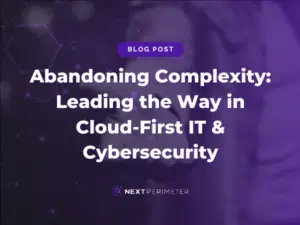The average business deploys plenty of technology, that much is true. You work alongside it–and often directly with it–but if you had to explain what it is to another person, could you? If you can’t, we’ve got your back. This month we will take you through a tour of the various technologies that your business uses, where they can be found, and what their general purpose is.
In the average office the outside door is where you begin to find technology. Today’s business is typically protected from the outside with a digital security system that features:
- Digital security cameras – Video surveillance systems allow security administrators to monitor the comings and goings of staff and guests to ensure threats are mitigated.
- Access control systems – Access control not only provides a place of business security from outside entries, it also provides a digital log of entrants. This allows for security reviews that can work to mitigate flow of unwelcome individuals and distractions inside the office.
- Digital signage – A digital sign is much like a static sign except it can play content providing a constant stream of information to people without dedicating manpower, and the cost associated with it.
After you get past the physical security you open the door to find the reception desk. You may find a digital sign or two, but you wouldn’t otherwise be inundated with much technology. The reception desk is filled with technology, however. Some technology that’s needed at a reception desk includes:
- Workstation – The workstation is the computer that most people utilize inside the office. It is typically a PC or Mac filled with productivity software, a customer resource management software, and any other type of software needed to complete the person’s job.
- Visitor management system – As an alternative to the dedicated access control systems, businesses that use reception may have a piece of software called a visitor management system in place that allows receptionists to schedule and log visitors into the office.
- VoIP – If a business so chooses, they can install a Voice over Internet Protocol telephone system that uses Internet bandwidth to place and accept calls. With a lot of excellent features, a VoIP platform can save a business money while providing them with the powerful phone system they need to communicate properly.
- Copier/Printer/Fax – Business technology often includes a Copier/Printer/Fax machine to allow staff to quickly make copies and print and send documents.
As you make your way past the reception desk, you will see many other workstations that are set up like the reception desk. Most will run different software (more on this later). Getting through the office you may find that most of the technology is hidden. This is accomplished through networking, whether with wires or wirelessly using the following technology.
- Modem – The modem is a piece of networking hardware that provides access to a High-Speed Internet connection.
- Network Switch – Network switches are used to physically connect multiple computers to one modem, allowing for multiple machines to have Internet access; and, creating what is referred to as your physical network.
- Router – For companies that prefer a wireless network to a physical network, the router does the same as a network switch except instead of using wires, it connects computers via Wi-Fi.
While networking gives companies the ability to centralize their network, the servers are the real center of any company’s computing infrastructure. That’s why, in the average office, you will find a server room. The server room is generally out of the way and inconspicuous. Besides networking hardware it could house the following types of servers:
- Domain Controller – This server dishes out all of the rules and user policies on the network. It handles a lot of security and access-related settings.
- Proxy Server – A server that sits between a web client and a web server to filter requests, improve performance and security.
- File Server – The most prevalent type of server. Used to provide location for shared disk access.
- Web Server – A type of file server that allows content to be viewed using Hypertext Transfer Protocol (HTTP).
- FTP Server – A file server that provides users the ability to move files securely from one server to another.
- Mail Server – A server that moves and stores mail over a corporate network and across the Internet.
- Application Server – A server that works to connect the databases applications need to work properly and end users.
- IM Server – Also known as a Real-Time communication server, enables large numbers of users to exchange information in real-time.
Some of these could be virtualized into a single device. There are several more types of servers your business may use, but these are the ones you will find in your average office. Where there are servers, there is file storage. Storage can come in many different types. Storage is typically measured in two ways: size and speed; and, is dictated by what the storage is being used for. The two types of hard drives you’ll find inside your server room are:
- Solid State Drive (SSD) – Traditionally more expensive, these faster drives usually come with less overall storage space.
- Hard Disk Drive (HDD) – Less expensive and more expansive, HDDs have (literally) more moving parts and are used for large-scale file storage.
Inside the server room you will also find the contingency hardware. This includes:
- Network-attached storage (NAS) – A single device with multiple drives that’s only job is to store company data.
- Backup and Disaster Recovery (BDR) – A NAS device that keeps onsite copies of the data while also regularly sending updated copies of the data to an offsite data center so that in the face of a disaster, data will still be recoverable.
Other technology you might find inside your organization’s server room include:
- Uninterruptible Power Supply (UPS) – A power outage or power surge isn’t exactly a freak occurrence. To mitigate the component-damaging blowback that these events can cause, a UPS is used to run core machines through. Like a surge protector that you would find in your home, a UPS is a commercial-grade device that keeps electricity from damaging your hardware, by evening out the electrical input allowing you time to properly shut down your machines.
- Firewall/Threat Management – Network security is extremely important for every organization that depends on its IT. A dedicated firewall or Unified Threat Management device houses strong software designed to keep bad actors and threats off of your business’ network.
That brings us to probably the most important aspect of your business. The thing that all the hardware would be just metal and plastic without: software. Software runs much of the modern world and besides the ones we’ve already listed, some of the software that most businesses use include:
- Operating Systems – The interfaces that allow businesses to manage and interact with their applications and files. Some operating systems are made for workstations, some for database management, and some are only for server management.
- Customer Relationship Management – Allows for customer (and often project) management, sales and marketing coordination, and a slew of other line of business purposes to be managed from one central software.
- Accounting/Payroll software – Every business needs to manage their revenue and it’s easier than ever with the powerful accounting software titles that lets businesses manage payroll, accounts receivable and more.
- Security software – Besides the software we’ve already discussed that run the visitor management and access control, there are firewalls, content filtering, spam protection, and more.
- Internet client – An Internet client is needed to access websites and web services.
- Email client – An email client is needed to send and receive emails.
- Messaging client – Same for messaging.
- Meeting software – With so many businesses relying on remote workers, having a conferencing software that allows teams to connect is important.
- Productivity software – Productivity software such as a word processor, spreadsheet program, note-taking app, and presentation software are necessary for most businesses. There are plenty of other pieces of software that allow for the completion of industry-specific jobs. Today’s most utilized ones also present collaboration options that make business move faster.
There you have it. If it seems as it is a lot to take in, it really is. At COMPANYNAME our industry professionals work day-in and day-out with business technology, providing IT expertise, services, and support to businesses of all types. There are plenty of situations we can help you with regarding IT procurement, design, and management. Call us today to learn more at 855-4IT-GUYS (855-448-4897).





